Music Streaming Services: Cultural and Economic Impact Analysis
VerifiedAdded on 2023/06/03
|19
|5681
|72
Report
AI Summary
This report explores the transformative impact of music streaming services on audience listening behaviors, examining both cultural and economic dimensions through the lens of public sphere and cultural intermediary theories. It highlights the shift from passive to active and interactive listening, driven by features that connect users and artists, enabling discussions, reviews, and personalized recommendations. The report also discusses how streaming has fostered explorative and discovery listening by providing access to a vast global catalog, contrasting with traditional limitations of local music. Furthermore, it addresses the de-contextualization of listening, as streaming offers anytime, anywhere access, diminishing the importance of live concerts. The study also notes how streaming platforms empower users with control over their music choices and enable networked and social listening through playlist sharing and social features, ultimately reshaping the public sphere and listener engagement.
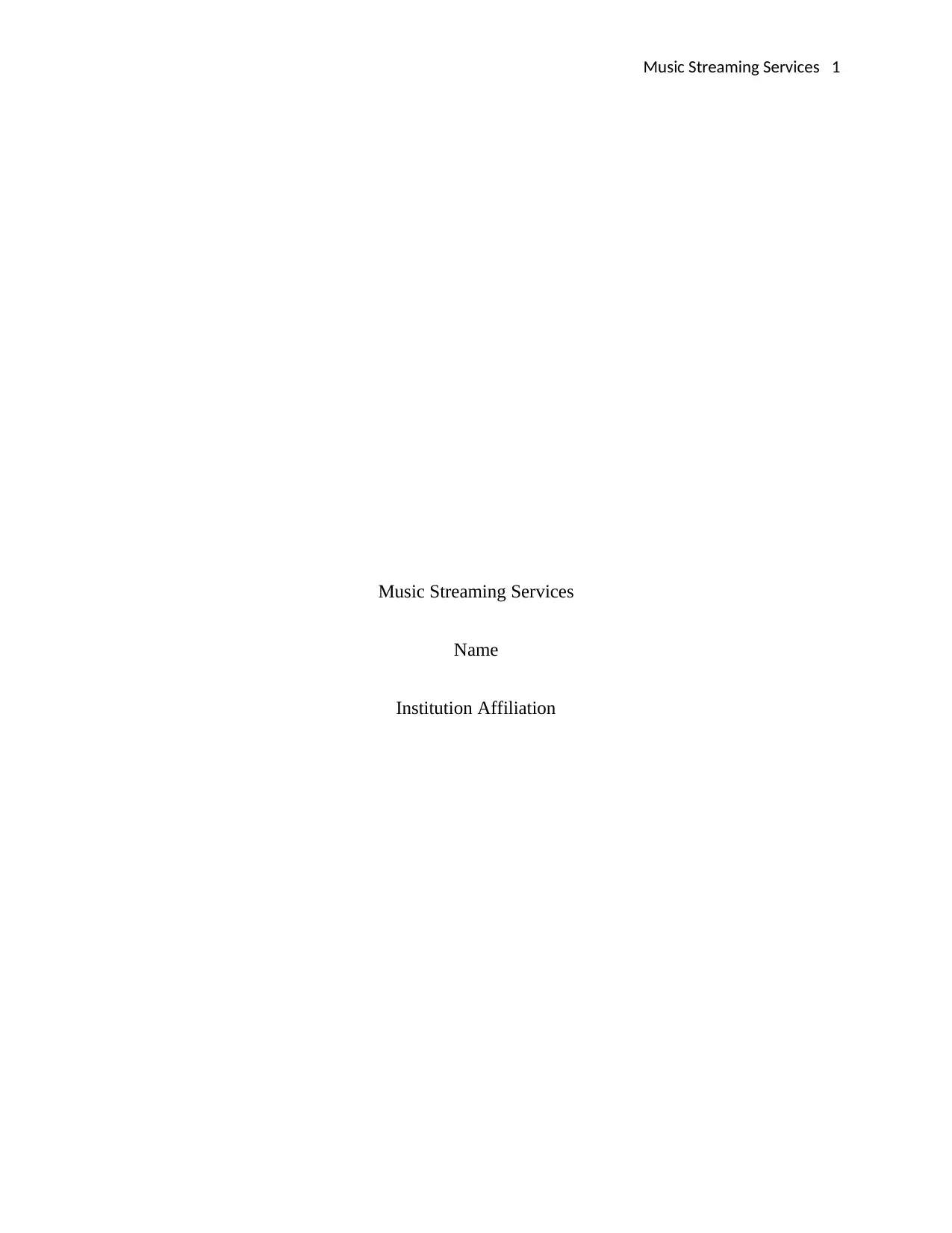
Music Streaming Services 1
Music Streaming Services
Name
Institution Affiliation
Music Streaming Services
Name
Institution Affiliation
Paraphrase This Document
Need a fresh take? Get an instant paraphrase of this document with our AI Paraphraser
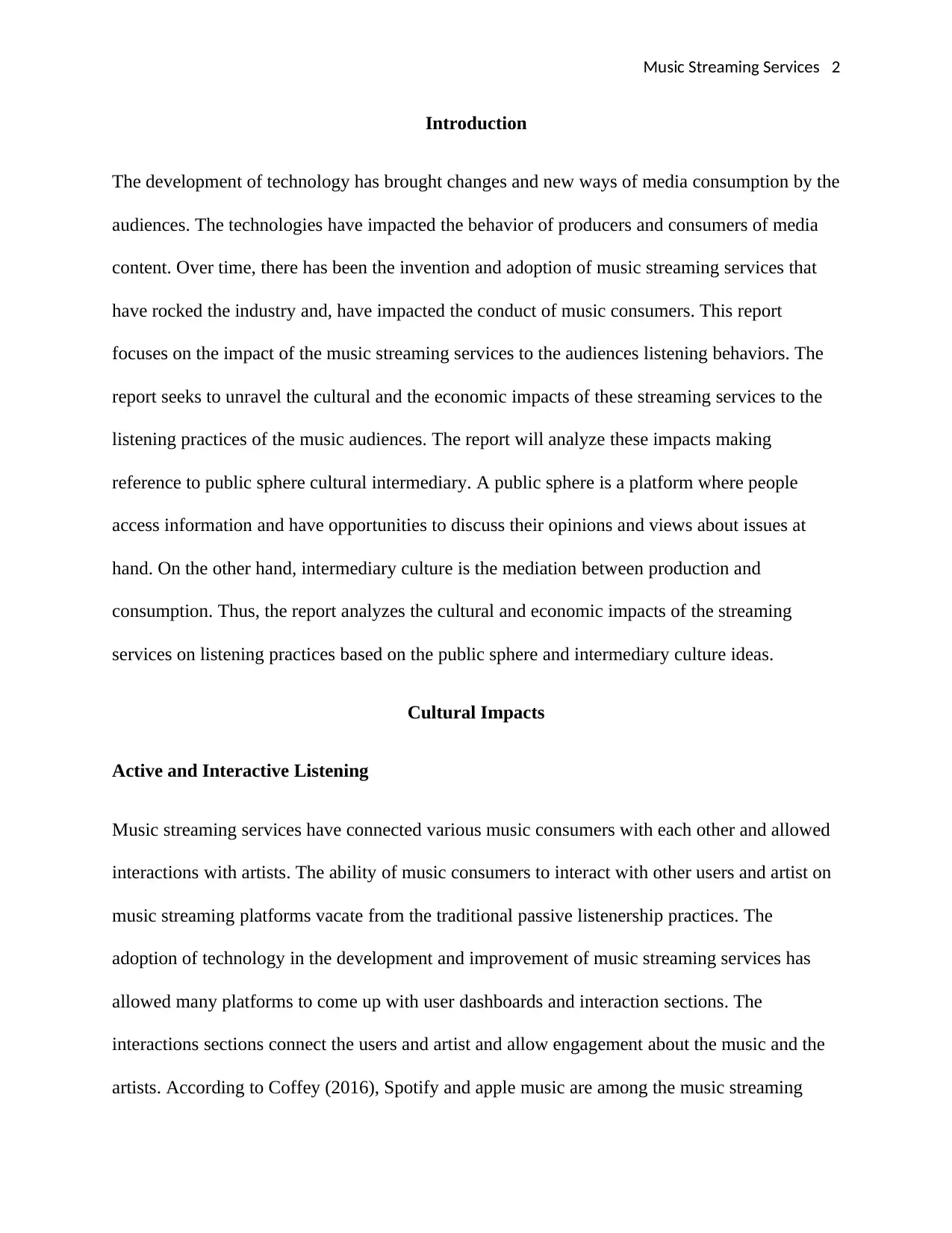
Music Streaming Services 2
Introduction
The development of technology has brought changes and new ways of media consumption by the
audiences. The technologies have impacted the behavior of producers and consumers of media
content. Over time, there has been the invention and adoption of music streaming services that
have rocked the industry and, have impacted the conduct of music consumers. This report
focuses on the impact of the music streaming services to the audiences listening behaviors. The
report seeks to unravel the cultural and the economic impacts of these streaming services to the
listening practices of the music audiences. The report will analyze these impacts making
reference to public sphere cultural intermediary. A public sphere is a platform where people
access information and have opportunities to discuss their opinions and views about issues at
hand. On the other hand, intermediary culture is the mediation between production and
consumption. Thus, the report analyzes the cultural and economic impacts of the streaming
services on listening practices based on the public sphere and intermediary culture ideas.
Cultural Impacts
Active and Interactive Listening
Music streaming services have connected various music consumers with each other and allowed
interactions with artists. The ability of music consumers to interact with other users and artist on
music streaming platforms vacate from the traditional passive listenership practices. The
adoption of technology in the development and improvement of music streaming services has
allowed many platforms to come up with user dashboards and interaction sections. The
interactions sections connect the users and artist and allow engagement about the music and the
artists. According to Coffey (2016), Spotify and apple music are among the music streaming
Introduction
The development of technology has brought changes and new ways of media consumption by the
audiences. The technologies have impacted the behavior of producers and consumers of media
content. Over time, there has been the invention and adoption of music streaming services that
have rocked the industry and, have impacted the conduct of music consumers. This report
focuses on the impact of the music streaming services to the audiences listening behaviors. The
report seeks to unravel the cultural and the economic impacts of these streaming services to the
listening practices of the music audiences. The report will analyze these impacts making
reference to public sphere cultural intermediary. A public sphere is a platform where people
access information and have opportunities to discuss their opinions and views about issues at
hand. On the other hand, intermediary culture is the mediation between production and
consumption. Thus, the report analyzes the cultural and economic impacts of the streaming
services on listening practices based on the public sphere and intermediary culture ideas.
Cultural Impacts
Active and Interactive Listening
Music streaming services have connected various music consumers with each other and allowed
interactions with artists. The ability of music consumers to interact with other users and artist on
music streaming platforms vacate from the traditional passive listenership practices. The
adoption of technology in the development and improvement of music streaming services has
allowed many platforms to come up with user dashboards and interaction sections. The
interactions sections connect the users and artist and allow engagement about the music and the
artists. According to Coffey (2016), Spotify and apple music are among the music streaming
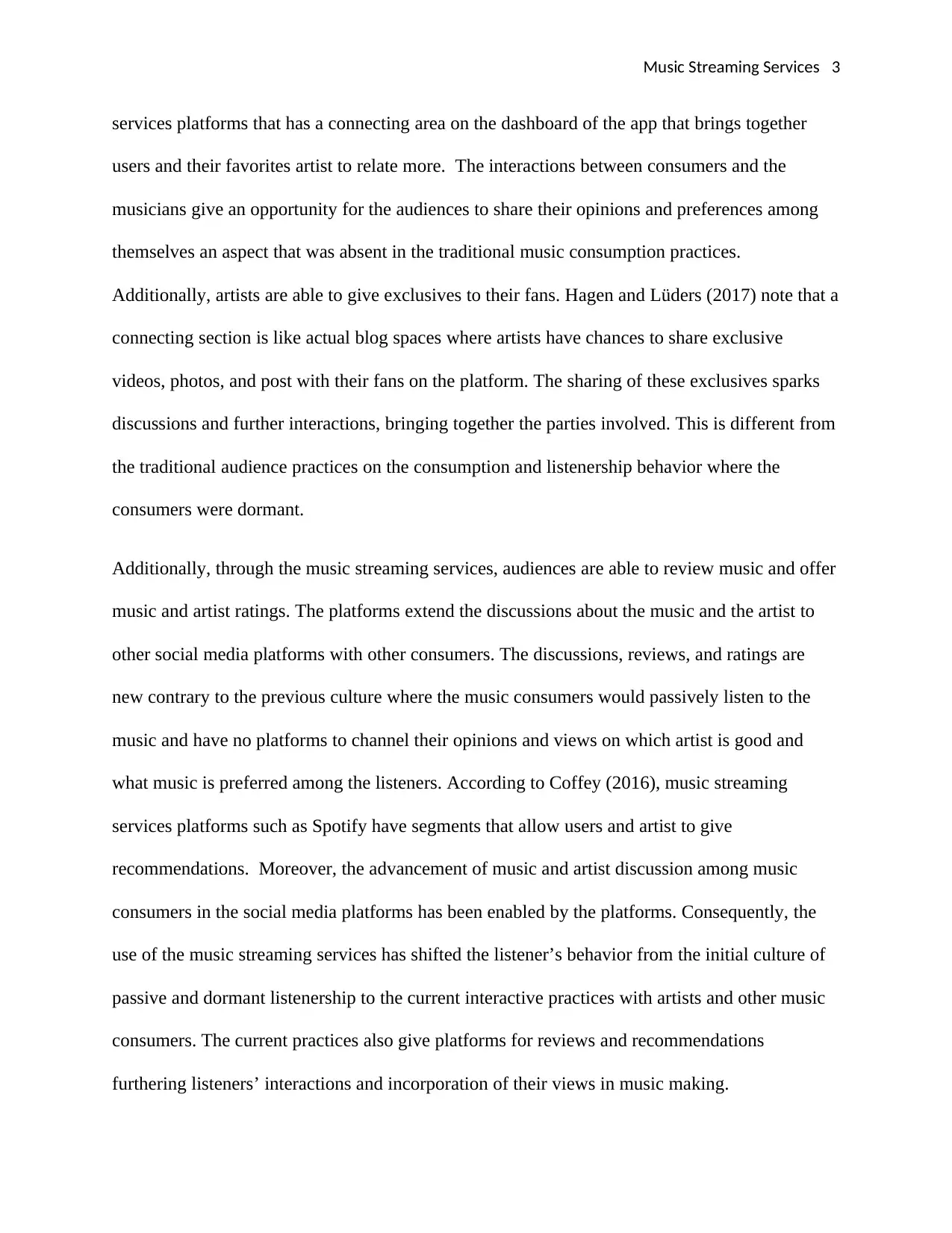
Music Streaming Services 3
services platforms that has a connecting area on the dashboard of the app that brings together
users and their favorites artist to relate more. The interactions between consumers and the
musicians give an opportunity for the audiences to share their opinions and preferences among
themselves an aspect that was absent in the traditional music consumption practices.
Additionally, artists are able to give exclusives to their fans. Hagen and Lüders (2017) note that a
connecting section is like actual blog spaces where artists have chances to share exclusive
videos, photos, and post with their fans on the platform. The sharing of these exclusives sparks
discussions and further interactions, bringing together the parties involved. This is different from
the traditional audience practices on the consumption and listenership behavior where the
consumers were dormant.
Additionally, through the music streaming services, audiences are able to review music and offer
music and artist ratings. The platforms extend the discussions about the music and the artist to
other social media platforms with other consumers. The discussions, reviews, and ratings are
new contrary to the previous culture where the music consumers would passively listen to the
music and have no platforms to channel their opinions and views on which artist is good and
what music is preferred among the listeners. According to Coffey (2016), music streaming
services platforms such as Spotify have segments that allow users and artist to give
recommendations. Moreover, the advancement of music and artist discussion among music
consumers in the social media platforms has been enabled by the platforms. Consequently, the
use of the music streaming services has shifted the listener’s behavior from the initial culture of
passive and dormant listenership to the current interactive practices with artists and other music
consumers. The current practices also give platforms for reviews and recommendations
furthering listeners’ interactions and incorporation of their views in music making.
services platforms that has a connecting area on the dashboard of the app that brings together
users and their favorites artist to relate more. The interactions between consumers and the
musicians give an opportunity for the audiences to share their opinions and preferences among
themselves an aspect that was absent in the traditional music consumption practices.
Additionally, artists are able to give exclusives to their fans. Hagen and Lüders (2017) note that a
connecting section is like actual blog spaces where artists have chances to share exclusive
videos, photos, and post with their fans on the platform. The sharing of these exclusives sparks
discussions and further interactions, bringing together the parties involved. This is different from
the traditional audience practices on the consumption and listenership behavior where the
consumers were dormant.
Additionally, through the music streaming services, audiences are able to review music and offer
music and artist ratings. The platforms extend the discussions about the music and the artist to
other social media platforms with other consumers. The discussions, reviews, and ratings are
new contrary to the previous culture where the music consumers would passively listen to the
music and have no platforms to channel their opinions and views on which artist is good and
what music is preferred among the listeners. According to Coffey (2016), music streaming
services platforms such as Spotify have segments that allow users and artist to give
recommendations. Moreover, the advancement of music and artist discussion among music
consumers in the social media platforms has been enabled by the platforms. Consequently, the
use of the music streaming services has shifted the listener’s behavior from the initial culture of
passive and dormant listenership to the current interactive practices with artists and other music
consumers. The current practices also give platforms for reviews and recommendations
furthering listeners’ interactions and incorporation of their views in music making.
⊘ This is a preview!⊘
Do you want full access?
Subscribe today to unlock all pages.

Trusted by 1+ million students worldwide
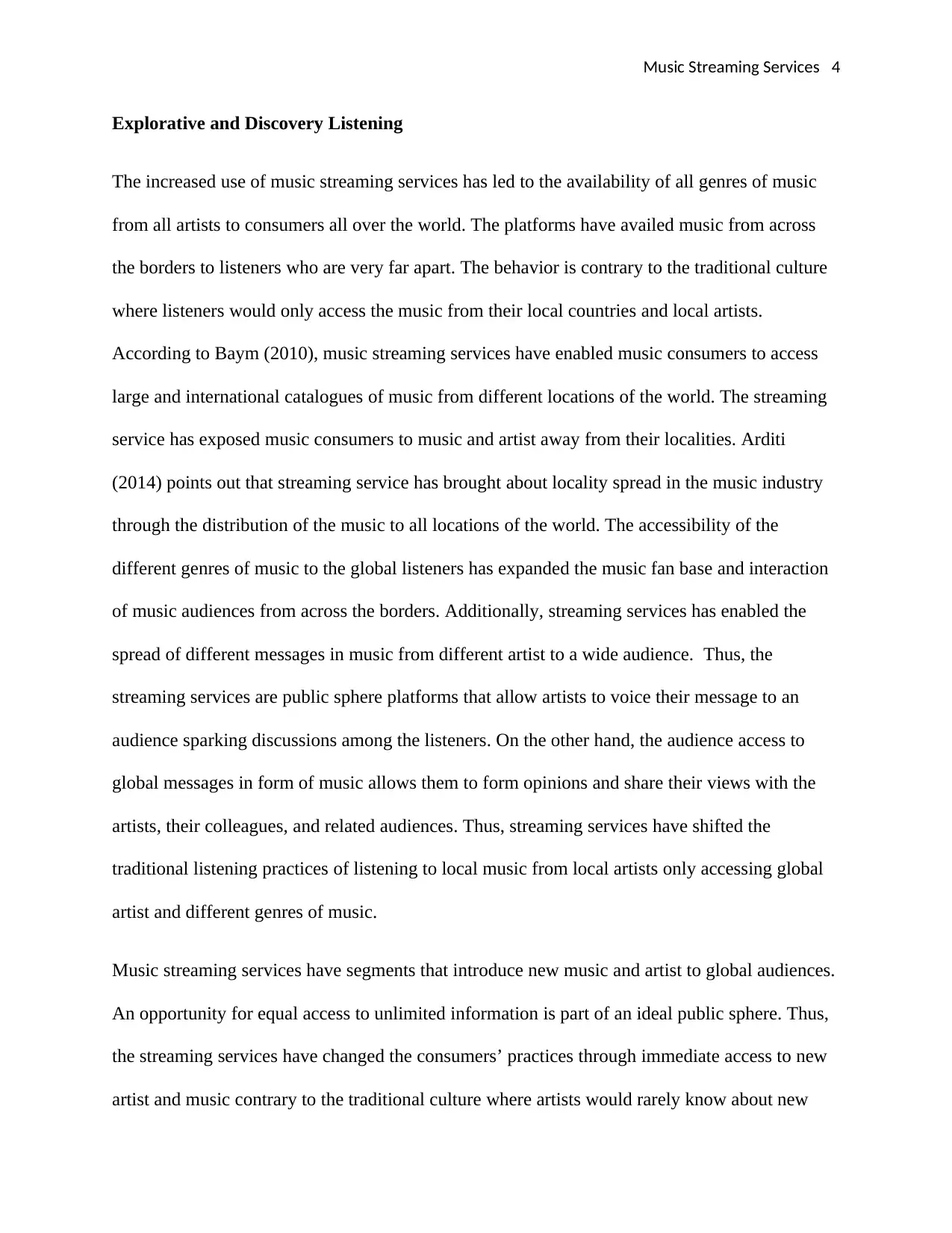
Music Streaming Services 4
Explorative and Discovery Listening
The increased use of music streaming services has led to the availability of all genres of music
from all artists to consumers all over the world. The platforms have availed music from across
the borders to listeners who are very far apart. The behavior is contrary to the traditional culture
where listeners would only access the music from their local countries and local artists.
According to Baym (2010), music streaming services have enabled music consumers to access
large and international catalogues of music from different locations of the world. The streaming
service has exposed music consumers to music and artist away from their localities. Arditi
(2014) points out that streaming service has brought about locality spread in the music industry
through the distribution of the music to all locations of the world. The accessibility of the
different genres of music to the global listeners has expanded the music fan base and interaction
of music audiences from across the borders. Additionally, streaming services has enabled the
spread of different messages in music from different artist to a wide audience. Thus, the
streaming services are public sphere platforms that allow artists to voice their message to an
audience sparking discussions among the listeners. On the other hand, the audience access to
global messages in form of music allows them to form opinions and share their views with the
artists, their colleagues, and related audiences. Thus, streaming services have shifted the
traditional listening practices of listening to local music from local artists only accessing global
artist and different genres of music.
Music streaming services have segments that introduce new music and artist to global audiences.
An opportunity for equal access to unlimited information is part of an ideal public sphere. Thus,
the streaming services have changed the consumers’ practices through immediate access to new
artist and music contrary to the traditional culture where artists would rarely know about new
Explorative and Discovery Listening
The increased use of music streaming services has led to the availability of all genres of music
from all artists to consumers all over the world. The platforms have availed music from across
the borders to listeners who are very far apart. The behavior is contrary to the traditional culture
where listeners would only access the music from their local countries and local artists.
According to Baym (2010), music streaming services have enabled music consumers to access
large and international catalogues of music from different locations of the world. The streaming
service has exposed music consumers to music and artist away from their localities. Arditi
(2014) points out that streaming service has brought about locality spread in the music industry
through the distribution of the music to all locations of the world. The accessibility of the
different genres of music to the global listeners has expanded the music fan base and interaction
of music audiences from across the borders. Additionally, streaming services has enabled the
spread of different messages in music from different artist to a wide audience. Thus, the
streaming services are public sphere platforms that allow artists to voice their message to an
audience sparking discussions among the listeners. On the other hand, the audience access to
global messages in form of music allows them to form opinions and share their views with the
artists, their colleagues, and related audiences. Thus, streaming services have shifted the
traditional listening practices of listening to local music from local artists only accessing global
artist and different genres of music.
Music streaming services have segments that introduce new music and artist to global audiences.
An opportunity for equal access to unlimited information is part of an ideal public sphere. Thus,
the streaming services have changed the consumers’ practices through immediate access to new
artist and music contrary to the traditional culture where artists would rarely know about new
Paraphrase This Document
Need a fresh take? Get an instant paraphrase of this document with our AI Paraphraser
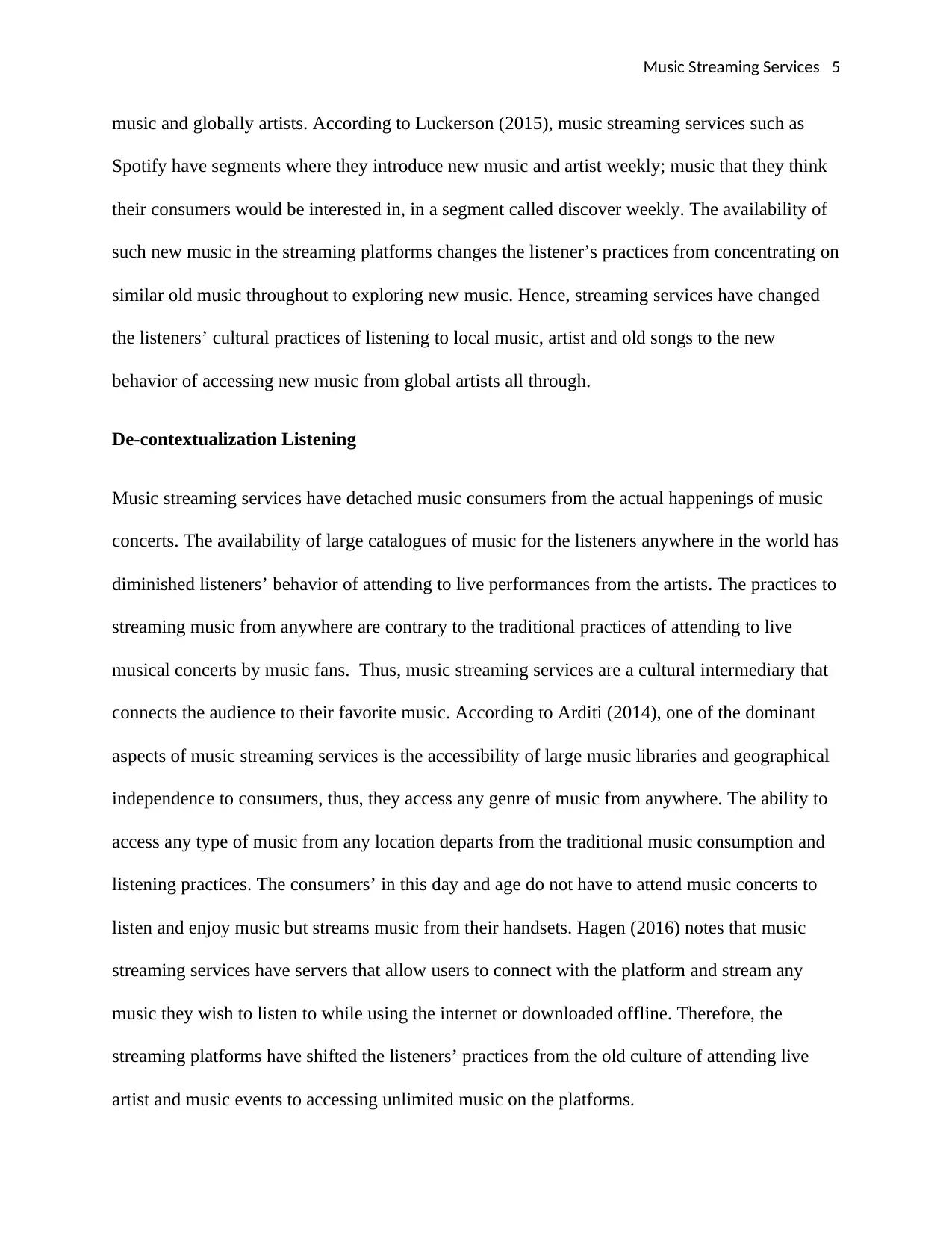
Music Streaming Services 5
music and globally artists. According to Luckerson (2015), music streaming services such as
Spotify have segments where they introduce new music and artist weekly; music that they think
their consumers would be interested in, in a segment called discover weekly. The availability of
such new music in the streaming platforms changes the listener’s practices from concentrating on
similar old music throughout to exploring new music. Hence, streaming services have changed
the listeners’ cultural practices of listening to local music, artist and old songs to the new
behavior of accessing new music from global artists all through.
De-contextualization Listening
Music streaming services have detached music consumers from the actual happenings of music
concerts. The availability of large catalogues of music for the listeners anywhere in the world has
diminished listeners’ behavior of attending to live performances from the artists. The practices to
streaming music from anywhere are contrary to the traditional practices of attending to live
musical concerts by music fans. Thus, music streaming services are a cultural intermediary that
connects the audience to their favorite music. According to Arditi (2014), one of the dominant
aspects of music streaming services is the accessibility of large music libraries and geographical
independence to consumers, thus, they access any genre of music from anywhere. The ability to
access any type of music from any location departs from the traditional music consumption and
listening practices. The consumers’ in this day and age do not have to attend music concerts to
listen and enjoy music but streams music from their handsets. Hagen (2016) notes that music
streaming services have servers that allow users to connect with the platform and stream any
music they wish to listen to while using the internet or downloaded offline. Therefore, the
streaming platforms have shifted the listeners’ practices from the old culture of attending live
artist and music events to accessing unlimited music on the platforms.
music and globally artists. According to Luckerson (2015), music streaming services such as
Spotify have segments where they introduce new music and artist weekly; music that they think
their consumers would be interested in, in a segment called discover weekly. The availability of
such new music in the streaming platforms changes the listener’s practices from concentrating on
similar old music throughout to exploring new music. Hence, streaming services have changed
the listeners’ cultural practices of listening to local music, artist and old songs to the new
behavior of accessing new music from global artists all through.
De-contextualization Listening
Music streaming services have detached music consumers from the actual happenings of music
concerts. The availability of large catalogues of music for the listeners anywhere in the world has
diminished listeners’ behavior of attending to live performances from the artists. The practices to
streaming music from anywhere are contrary to the traditional practices of attending to live
musical concerts by music fans. Thus, music streaming services are a cultural intermediary that
connects the audience to their favorite music. According to Arditi (2014), one of the dominant
aspects of music streaming services is the accessibility of large music libraries and geographical
independence to consumers, thus, they access any genre of music from anywhere. The ability to
access any type of music from any location departs from the traditional music consumption and
listening practices. The consumers’ in this day and age do not have to attend music concerts to
listen and enjoy music but streams music from their handsets. Hagen (2016) notes that music
streaming services have servers that allow users to connect with the platform and stream any
music they wish to listen to while using the internet or downloaded offline. Therefore, the
streaming platforms have shifted the listeners’ practices from the old culture of attending live
artist and music events to accessing unlimited music on the platforms.
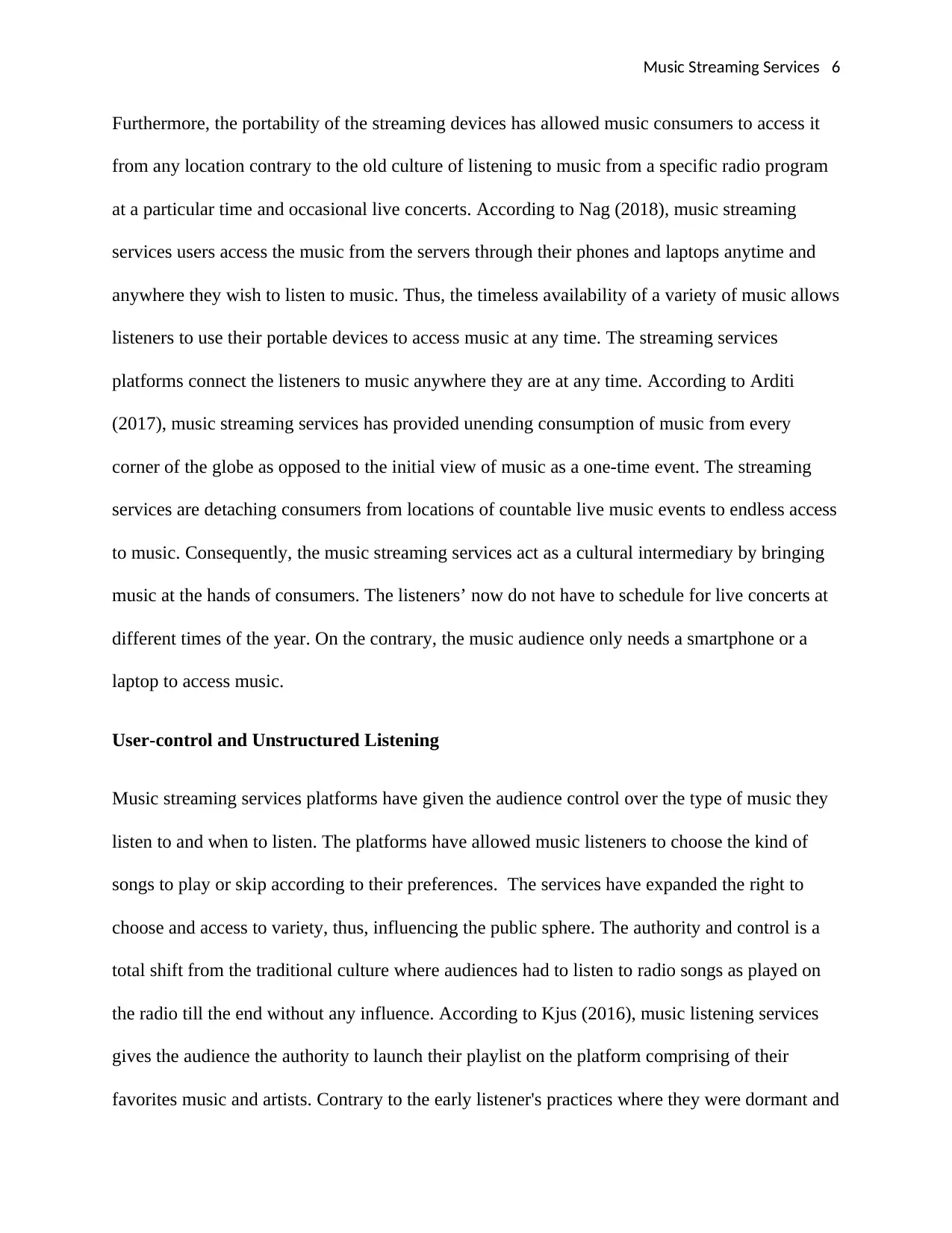
Music Streaming Services 6
Furthermore, the portability of the streaming devices has allowed music consumers to access it
from any location contrary to the old culture of listening to music from a specific radio program
at a particular time and occasional live concerts. According to Nag (2018), music streaming
services users access the music from the servers through their phones and laptops anytime and
anywhere they wish to listen to music. Thus, the timeless availability of a variety of music allows
listeners to use their portable devices to access music at any time. The streaming services
platforms connect the listeners to music anywhere they are at any time. According to Arditi
(2017), music streaming services has provided unending consumption of music from every
corner of the globe as opposed to the initial view of music as a one-time event. The streaming
services are detaching consumers from locations of countable live music events to endless access
to music. Consequently, the music streaming services act as a cultural intermediary by bringing
music at the hands of consumers. The listeners’ now do not have to schedule for live concerts at
different times of the year. On the contrary, the music audience only needs a smartphone or a
laptop to access music.
User-control and Unstructured Listening
Music streaming services platforms have given the audience control over the type of music they
listen to and when to listen. The platforms have allowed music listeners to choose the kind of
songs to play or skip according to their preferences. The services have expanded the right to
choose and access to variety, thus, influencing the public sphere. The authority and control is a
total shift from the traditional culture where audiences had to listen to radio songs as played on
the radio till the end without any influence. According to Kjus (2016), music listening services
gives the audience the authority to launch their playlist on the platform comprising of their
favorites music and artists. Contrary to the early listener's practices where they were dormant and
Furthermore, the portability of the streaming devices has allowed music consumers to access it
from any location contrary to the old culture of listening to music from a specific radio program
at a particular time and occasional live concerts. According to Nag (2018), music streaming
services users access the music from the servers through their phones and laptops anytime and
anywhere they wish to listen to music. Thus, the timeless availability of a variety of music allows
listeners to use their portable devices to access music at any time. The streaming services
platforms connect the listeners to music anywhere they are at any time. According to Arditi
(2017), music streaming services has provided unending consumption of music from every
corner of the globe as opposed to the initial view of music as a one-time event. The streaming
services are detaching consumers from locations of countable live music events to endless access
to music. Consequently, the music streaming services act as a cultural intermediary by bringing
music at the hands of consumers. The listeners’ now do not have to schedule for live concerts at
different times of the year. On the contrary, the music audience only needs a smartphone or a
laptop to access music.
User-control and Unstructured Listening
Music streaming services platforms have given the audience control over the type of music they
listen to and when to listen. The platforms have allowed music listeners to choose the kind of
songs to play or skip according to their preferences. The services have expanded the right to
choose and access to variety, thus, influencing the public sphere. The authority and control is a
total shift from the traditional culture where audiences had to listen to radio songs as played on
the radio till the end without any influence. According to Kjus (2016), music listening services
gives the audience the authority to launch their playlist on the platform comprising of their
favorites music and artists. Contrary to the early listener's practices where they were dormant and
⊘ This is a preview!⊘
Do you want full access?
Subscribe today to unlock all pages.

Trusted by 1+ million students worldwide
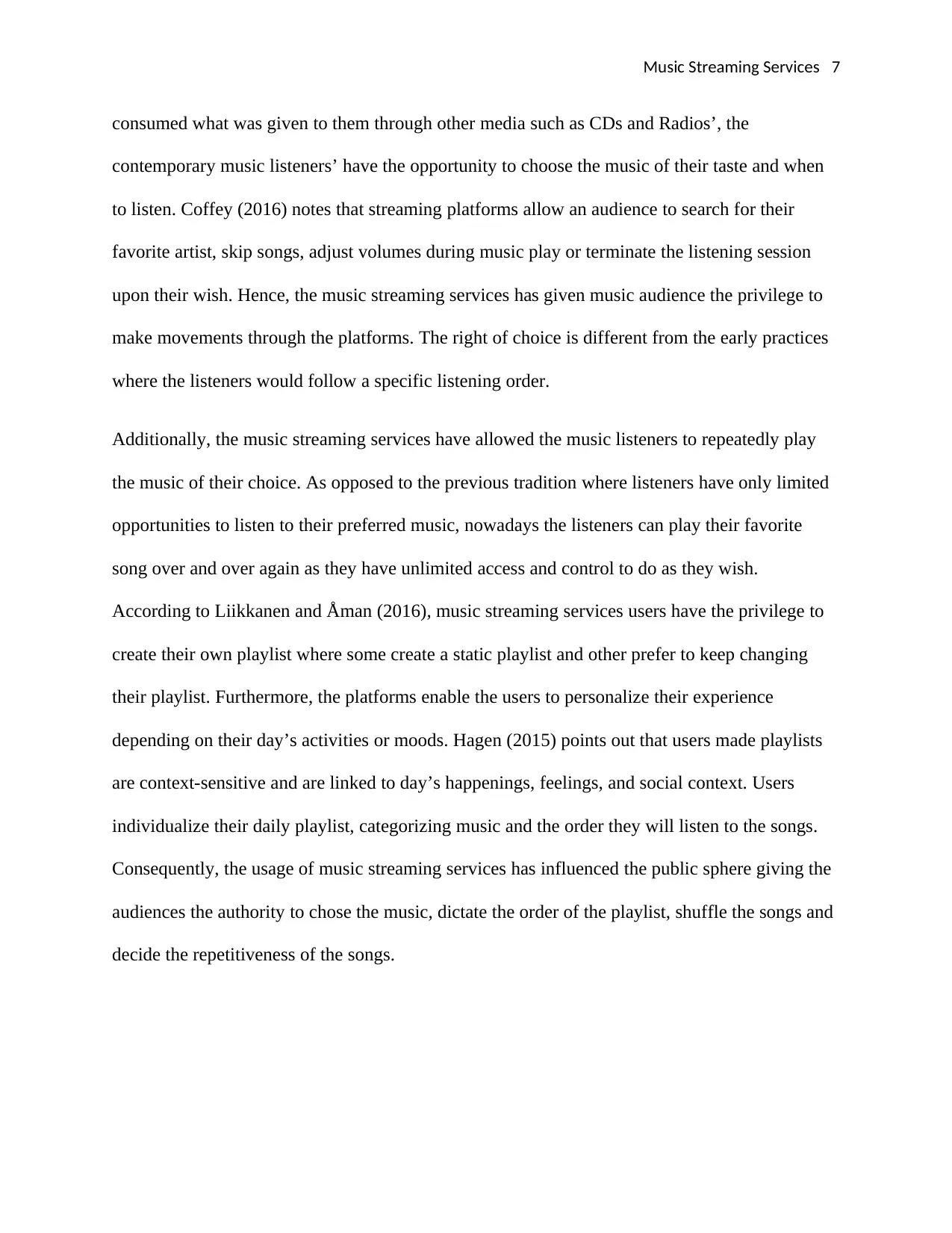
Music Streaming Services 7
consumed what was given to them through other media such as CDs and Radios’, the
contemporary music listeners’ have the opportunity to choose the music of their taste and when
to listen. Coffey (2016) notes that streaming platforms allow an audience to search for their
favorite artist, skip songs, adjust volumes during music play or terminate the listening session
upon their wish. Hence, the music streaming services has given music audience the privilege to
make movements through the platforms. The right of choice is different from the early practices
where the listeners would follow a specific listening order.
Additionally, the music streaming services have allowed the music listeners to repeatedly play
the music of their choice. As opposed to the previous tradition where listeners have only limited
opportunities to listen to their preferred music, nowadays the listeners can play their favorite
song over and over again as they have unlimited access and control to do as they wish.
According to Liikkanen and Åman (2016), music streaming services users have the privilege to
create their own playlist where some create a static playlist and other prefer to keep changing
their playlist. Furthermore, the platforms enable the users to personalize their experience
depending on their day’s activities or moods. Hagen (2015) points out that users made playlists
are context-sensitive and are linked to day’s happenings, feelings, and social context. Users
individualize their daily playlist, categorizing music and the order they will listen to the songs.
Consequently, the usage of music streaming services has influenced the public sphere giving the
audiences the authority to chose the music, dictate the order of the playlist, shuffle the songs and
decide the repetitiveness of the songs.
consumed what was given to them through other media such as CDs and Radios’, the
contemporary music listeners’ have the opportunity to choose the music of their taste and when
to listen. Coffey (2016) notes that streaming platforms allow an audience to search for their
favorite artist, skip songs, adjust volumes during music play or terminate the listening session
upon their wish. Hence, the music streaming services has given music audience the privilege to
make movements through the platforms. The right of choice is different from the early practices
where the listeners would follow a specific listening order.
Additionally, the music streaming services have allowed the music listeners to repeatedly play
the music of their choice. As opposed to the previous tradition where listeners have only limited
opportunities to listen to their preferred music, nowadays the listeners can play their favorite
song over and over again as they have unlimited access and control to do as they wish.
According to Liikkanen and Åman (2016), music streaming services users have the privilege to
create their own playlist where some create a static playlist and other prefer to keep changing
their playlist. Furthermore, the platforms enable the users to personalize their experience
depending on their day’s activities or moods. Hagen (2015) points out that users made playlists
are context-sensitive and are linked to day’s happenings, feelings, and social context. Users
individualize their daily playlist, categorizing music and the order they will listen to the songs.
Consequently, the usage of music streaming services has influenced the public sphere giving the
audiences the authority to chose the music, dictate the order of the playlist, shuffle the songs and
decide the repetitiveness of the songs.
Paraphrase This Document
Need a fresh take? Get an instant paraphrase of this document with our AI Paraphraser
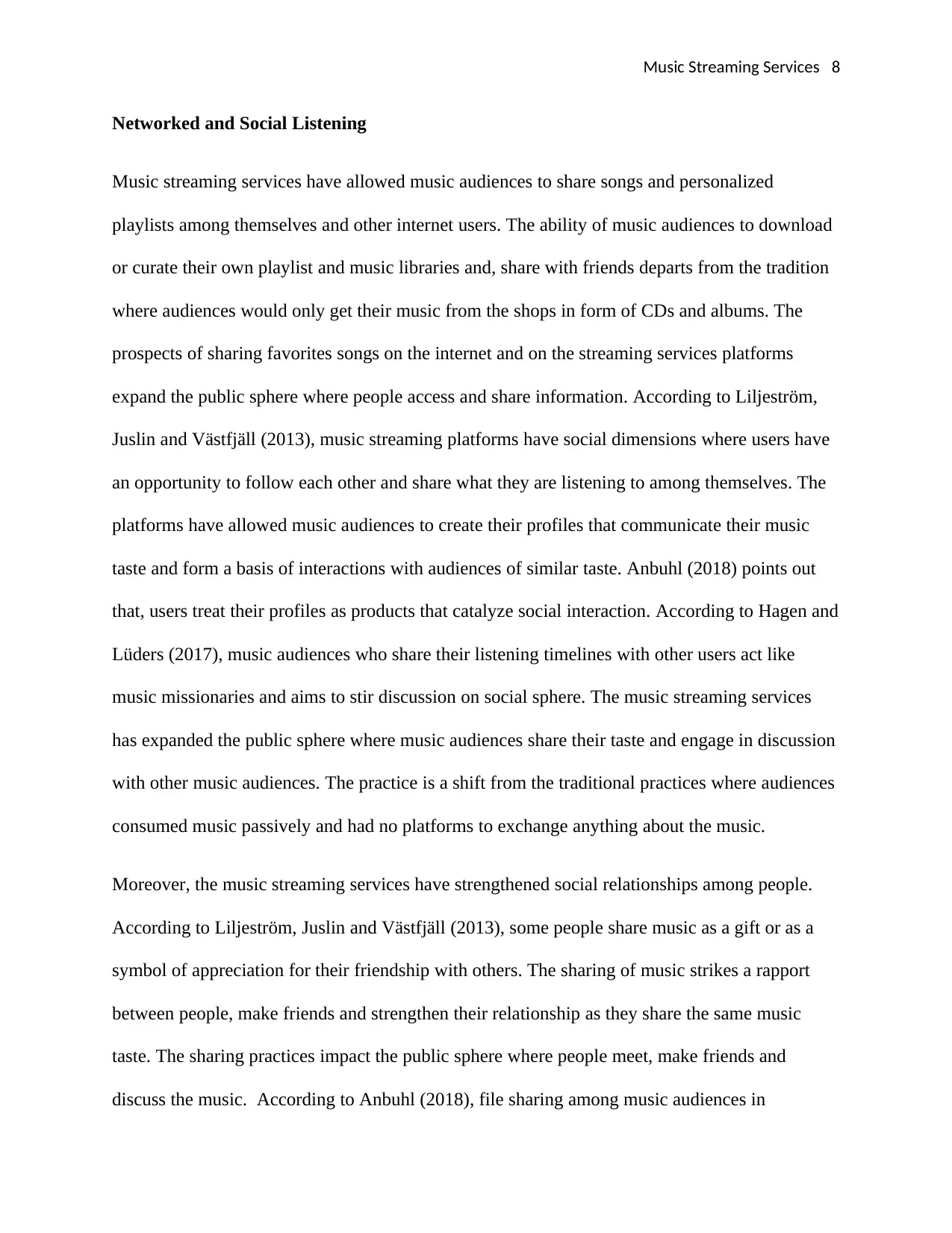
Music Streaming Services 8
Networked and Social Listening
Music streaming services have allowed music audiences to share songs and personalized
playlists among themselves and other internet users. The ability of music audiences to download
or curate their own playlist and music libraries and, share with friends departs from the tradition
where audiences would only get their music from the shops in form of CDs and albums. The
prospects of sharing favorites songs on the internet and on the streaming services platforms
expand the public sphere where people access and share information. According to Liljeström,
Juslin and Västfjäll (2013), music streaming platforms have social dimensions where users have
an opportunity to follow each other and share what they are listening to among themselves. The
platforms have allowed music audiences to create their profiles that communicate their music
taste and form a basis of interactions with audiences of similar taste. Anbuhl (2018) points out
that, users treat their profiles as products that catalyze social interaction. According to Hagen and
Lüders (2017), music audiences who share their listening timelines with other users act like
music missionaries and aims to stir discussion on social sphere. The music streaming services
has expanded the public sphere where music audiences share their taste and engage in discussion
with other music audiences. The practice is a shift from the traditional practices where audiences
consumed music passively and had no platforms to exchange anything about the music.
Moreover, the music streaming services have strengthened social relationships among people.
According to Liljeström, Juslin and Västfjäll (2013), some people share music as a gift or as a
symbol of appreciation for their friendship with others. The sharing of music strikes a rapport
between people, make friends and strengthen their relationship as they share the same music
taste. The sharing practices impact the public sphere where people meet, make friends and
discuss the music. According to Anbuhl (2018), file sharing among music audiences in
Networked and Social Listening
Music streaming services have allowed music audiences to share songs and personalized
playlists among themselves and other internet users. The ability of music audiences to download
or curate their own playlist and music libraries and, share with friends departs from the tradition
where audiences would only get their music from the shops in form of CDs and albums. The
prospects of sharing favorites songs on the internet and on the streaming services platforms
expand the public sphere where people access and share information. According to Liljeström,
Juslin and Västfjäll (2013), music streaming platforms have social dimensions where users have
an opportunity to follow each other and share what they are listening to among themselves. The
platforms have allowed music audiences to create their profiles that communicate their music
taste and form a basis of interactions with audiences of similar taste. Anbuhl (2018) points out
that, users treat their profiles as products that catalyze social interaction. According to Hagen and
Lüders (2017), music audiences who share their listening timelines with other users act like
music missionaries and aims to stir discussion on social sphere. The music streaming services
has expanded the public sphere where music audiences share their taste and engage in discussion
with other music audiences. The practice is a shift from the traditional practices where audiences
consumed music passively and had no platforms to exchange anything about the music.
Moreover, the music streaming services have strengthened social relationships among people.
According to Liljeström, Juslin and Västfjäll (2013), some people share music as a gift or as a
symbol of appreciation for their friendship with others. The sharing of music strikes a rapport
between people, make friends and strengthen their relationship as they share the same music
taste. The sharing practices impact the public sphere where people meet, make friends and
discuss the music. According to Anbuhl (2018), file sharing among music audiences in
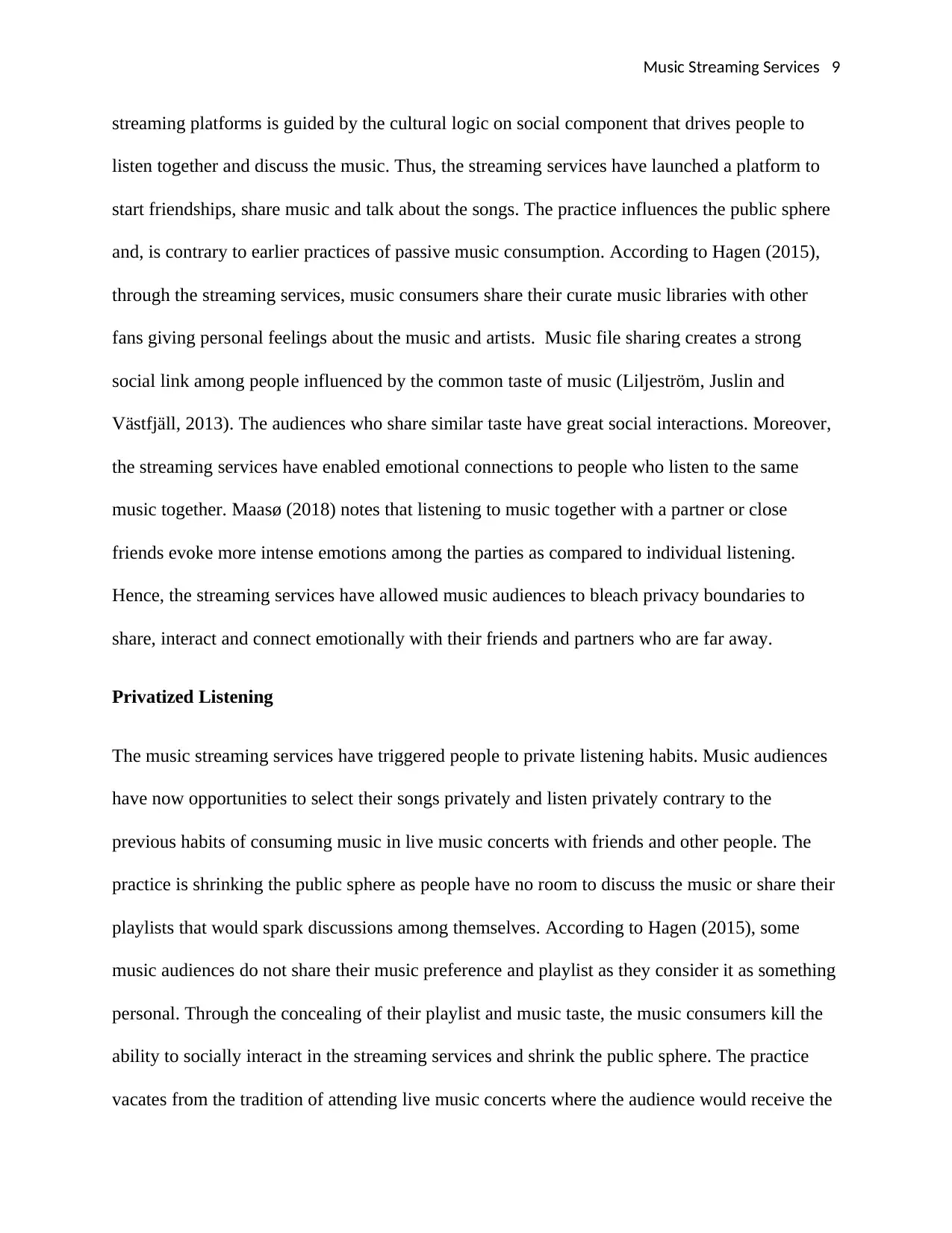
Music Streaming Services 9
streaming platforms is guided by the cultural logic on social component that drives people to
listen together and discuss the music. Thus, the streaming services have launched a platform to
start friendships, share music and talk about the songs. The practice influences the public sphere
and, is contrary to earlier practices of passive music consumption. According to Hagen (2015),
through the streaming services, music consumers share their curate music libraries with other
fans giving personal feelings about the music and artists. Music file sharing creates a strong
social link among people influenced by the common taste of music (Liljeström, Juslin and
Västfjäll, 2013). The audiences who share similar taste have great social interactions. Moreover,
the streaming services have enabled emotional connections to people who listen to the same
music together. Maasø (2018) notes that listening to music together with a partner or close
friends evoke more intense emotions among the parties as compared to individual listening.
Hence, the streaming services have allowed music audiences to bleach privacy boundaries to
share, interact and connect emotionally with their friends and partners who are far away.
Privatized Listening
The music streaming services have triggered people to private listening habits. Music audiences
have now opportunities to select their songs privately and listen privately contrary to the
previous habits of consuming music in live music concerts with friends and other people. The
practice is shrinking the public sphere as people have no room to discuss the music or share their
playlists that would spark discussions among themselves. According to Hagen (2015), some
music audiences do not share their music preference and playlist as they consider it as something
personal. Through the concealing of their playlist and music taste, the music consumers kill the
ability to socially interact in the streaming services and shrink the public sphere. The practice
vacates from the tradition of attending live music concerts where the audience would receive the
streaming platforms is guided by the cultural logic on social component that drives people to
listen together and discuss the music. Thus, the streaming services have launched a platform to
start friendships, share music and talk about the songs. The practice influences the public sphere
and, is contrary to earlier practices of passive music consumption. According to Hagen (2015),
through the streaming services, music consumers share their curate music libraries with other
fans giving personal feelings about the music and artists. Music file sharing creates a strong
social link among people influenced by the common taste of music (Liljeström, Juslin and
Västfjäll, 2013). The audiences who share similar taste have great social interactions. Moreover,
the streaming services have enabled emotional connections to people who listen to the same
music together. Maasø (2018) notes that listening to music together with a partner or close
friends evoke more intense emotions among the parties as compared to individual listening.
Hence, the streaming services have allowed music audiences to bleach privacy boundaries to
share, interact and connect emotionally with their friends and partners who are far away.
Privatized Listening
The music streaming services have triggered people to private listening habits. Music audiences
have now opportunities to select their songs privately and listen privately contrary to the
previous habits of consuming music in live music concerts with friends and other people. The
practice is shrinking the public sphere as people have no room to discuss the music or share their
playlists that would spark discussions among themselves. According to Hagen (2015), some
music audiences do not share their music preference and playlist as they consider it as something
personal. Through the concealing of their playlist and music taste, the music consumers kill the
ability to socially interact in the streaming services and shrink the public sphere. The practice
vacates from the tradition of attending live music concerts where the audience would receive the
⊘ This is a preview!⊘
Do you want full access?
Subscribe today to unlock all pages.

Trusted by 1+ million students worldwide
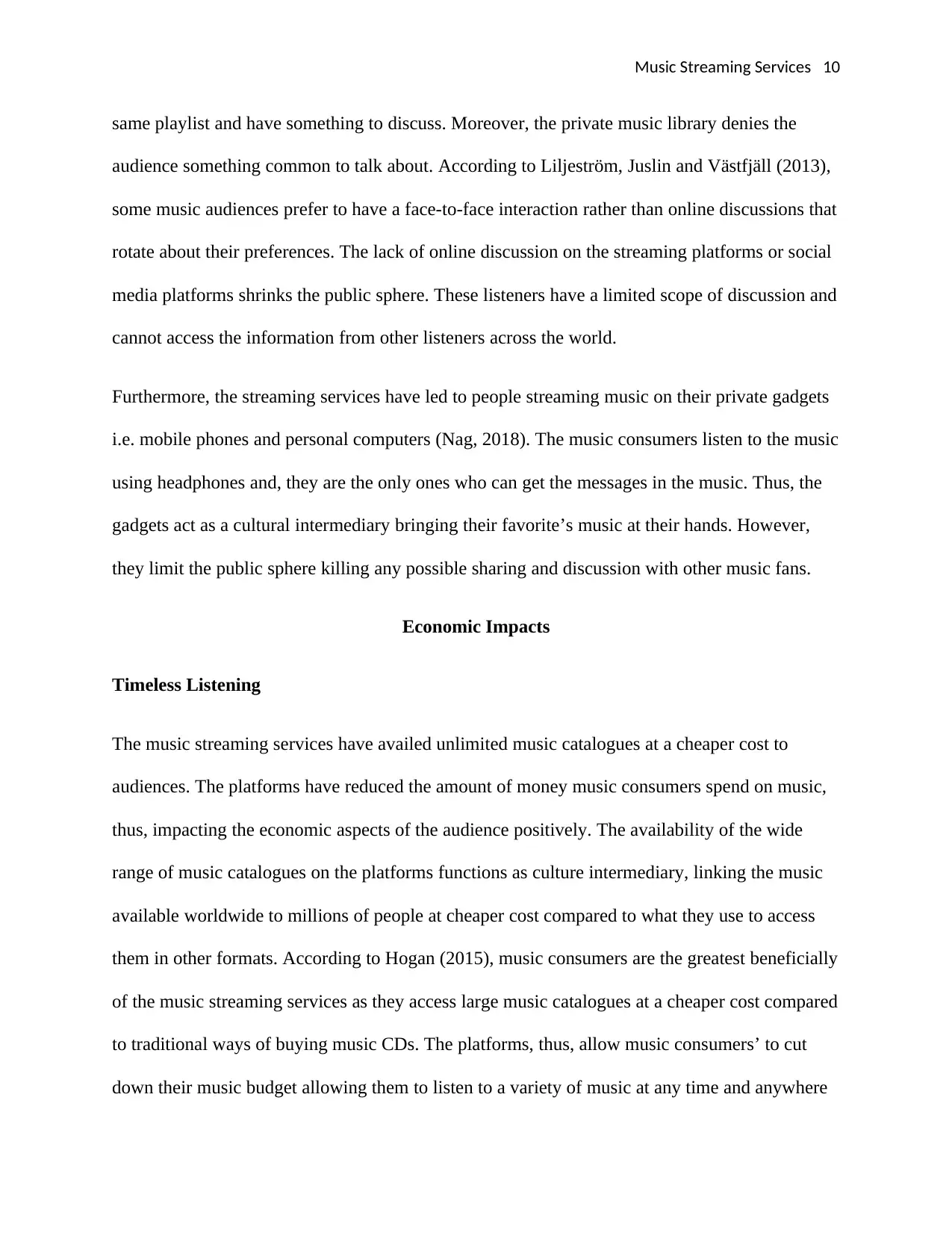
Music Streaming Services 10
same playlist and have something to discuss. Moreover, the private music library denies the
audience something common to talk about. According to Liljeström, Juslin and Västfjäll (2013),
some music audiences prefer to have a face-to-face interaction rather than online discussions that
rotate about their preferences. The lack of online discussion on the streaming platforms or social
media platforms shrinks the public sphere. These listeners have a limited scope of discussion and
cannot access the information from other listeners across the world.
Furthermore, the streaming services have led to people streaming music on their private gadgets
i.e. mobile phones and personal computers (Nag, 2018). The music consumers listen to the music
using headphones and, they are the only ones who can get the messages in the music. Thus, the
gadgets act as a cultural intermediary bringing their favorite’s music at their hands. However,
they limit the public sphere killing any possible sharing and discussion with other music fans.
Economic Impacts
Timeless Listening
The music streaming services have availed unlimited music catalogues at a cheaper cost to
audiences. The platforms have reduced the amount of money music consumers spend on music,
thus, impacting the economic aspects of the audience positively. The availability of the wide
range of music catalogues on the platforms functions as culture intermediary, linking the music
available worldwide to millions of people at cheaper cost compared to what they use to access
them in other formats. According to Hogan (2015), music consumers are the greatest beneficially
of the music streaming services as they access large music catalogues at a cheaper cost compared
to traditional ways of buying music CDs. The platforms, thus, allow music consumers’ to cut
down their music budget allowing them to listen to a variety of music at any time and anywhere
same playlist and have something to discuss. Moreover, the private music library denies the
audience something common to talk about. According to Liljeström, Juslin and Västfjäll (2013),
some music audiences prefer to have a face-to-face interaction rather than online discussions that
rotate about their preferences. The lack of online discussion on the streaming platforms or social
media platforms shrinks the public sphere. These listeners have a limited scope of discussion and
cannot access the information from other listeners across the world.
Furthermore, the streaming services have led to people streaming music on their private gadgets
i.e. mobile phones and personal computers (Nag, 2018). The music consumers listen to the music
using headphones and, they are the only ones who can get the messages in the music. Thus, the
gadgets act as a cultural intermediary bringing their favorite’s music at their hands. However,
they limit the public sphere killing any possible sharing and discussion with other music fans.
Economic Impacts
Timeless Listening
The music streaming services have availed unlimited music catalogues at a cheaper cost to
audiences. The platforms have reduced the amount of money music consumers spend on music,
thus, impacting the economic aspects of the audience positively. The availability of the wide
range of music catalogues on the platforms functions as culture intermediary, linking the music
available worldwide to millions of people at cheaper cost compared to what they use to access
them in other formats. According to Hogan (2015), music consumers are the greatest beneficially
of the music streaming services as they access large music catalogues at a cheaper cost compared
to traditional ways of buying music CDs. The platforms, thus, allow music consumers’ to cut
down their music budget allowing them to listen to a variety of music at any time and anywhere
Paraphrase This Document
Need a fresh take? Get an instant paraphrase of this document with our AI Paraphraser
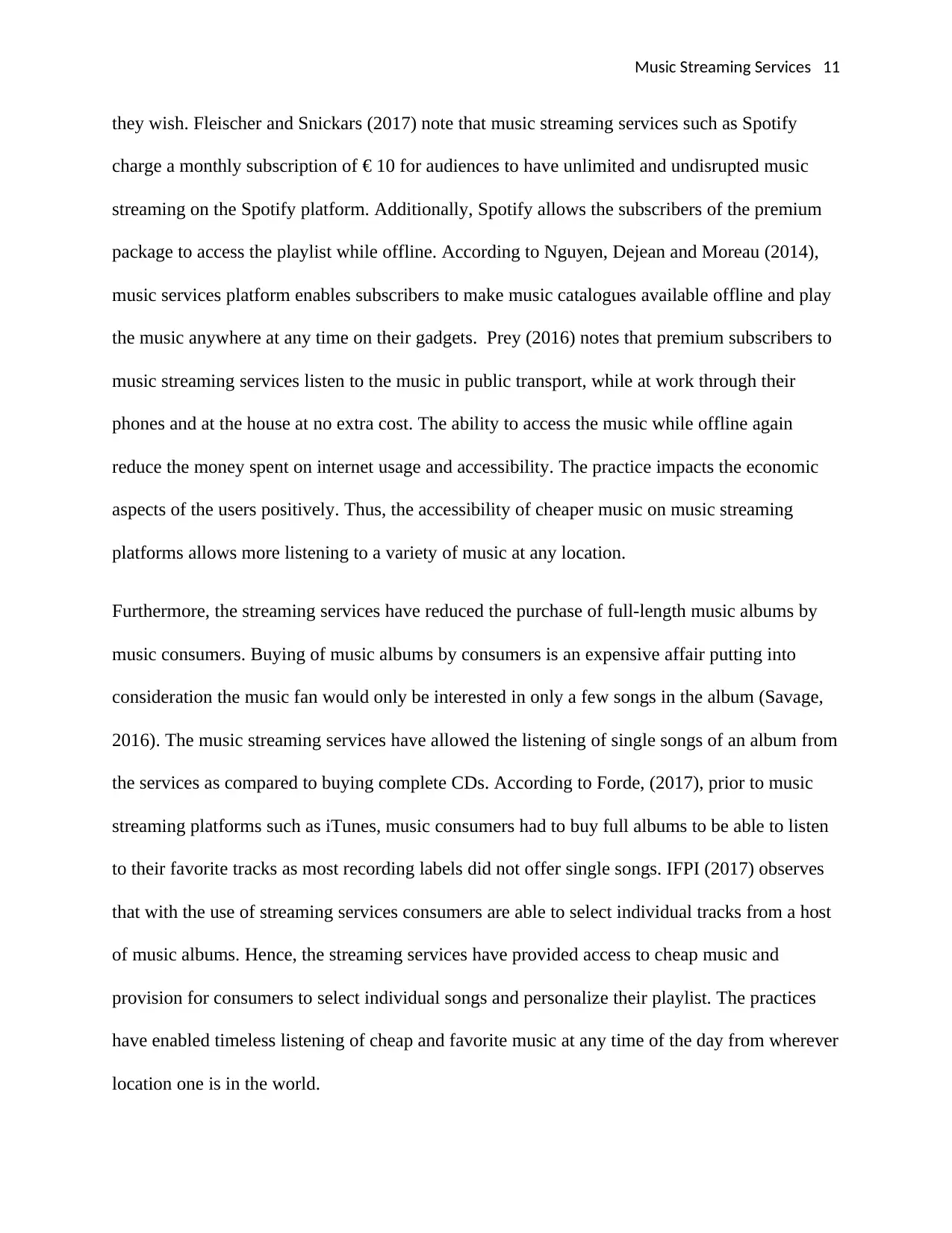
Music Streaming Services 11
they wish. Fleischer and Snickars (2017) note that music streaming services such as Spotify
charge a monthly subscription of € 10 for audiences to have unlimited and undisrupted music
streaming on the Spotify platform. Additionally, Spotify allows the subscribers of the premium
package to access the playlist while offline. According to Nguyen, Dejean and Moreau (2014),
music services platform enables subscribers to make music catalogues available offline and play
the music anywhere at any time on their gadgets. Prey (2016) notes that premium subscribers to
music streaming services listen to the music in public transport, while at work through their
phones and at the house at no extra cost. The ability to access the music while offline again
reduce the money spent on internet usage and accessibility. The practice impacts the economic
aspects of the users positively. Thus, the accessibility of cheaper music on music streaming
platforms allows more listening to a variety of music at any location.
Furthermore, the streaming services have reduced the purchase of full-length music albums by
music consumers. Buying of music albums by consumers is an expensive affair putting into
consideration the music fan would only be interested in only a few songs in the album (Savage,
2016). The music streaming services have allowed the listening of single songs of an album from
the services as compared to buying complete CDs. According to Forde, (2017), prior to music
streaming platforms such as iTunes, music consumers had to buy full albums to be able to listen
to their favorite tracks as most recording labels did not offer single songs. IFPI (2017) observes
that with the use of streaming services consumers are able to select individual tracks from a host
of music albums. Hence, the streaming services have provided access to cheap music and
provision for consumers to select individual songs and personalize their playlist. The practices
have enabled timeless listening of cheap and favorite music at any time of the day from wherever
location one is in the world.
they wish. Fleischer and Snickars (2017) note that music streaming services such as Spotify
charge a monthly subscription of € 10 for audiences to have unlimited and undisrupted music
streaming on the Spotify platform. Additionally, Spotify allows the subscribers of the premium
package to access the playlist while offline. According to Nguyen, Dejean and Moreau (2014),
music services platform enables subscribers to make music catalogues available offline and play
the music anywhere at any time on their gadgets. Prey (2016) notes that premium subscribers to
music streaming services listen to the music in public transport, while at work through their
phones and at the house at no extra cost. The ability to access the music while offline again
reduce the money spent on internet usage and accessibility. The practice impacts the economic
aspects of the users positively. Thus, the accessibility of cheaper music on music streaming
platforms allows more listening to a variety of music at any location.
Furthermore, the streaming services have reduced the purchase of full-length music albums by
music consumers. Buying of music albums by consumers is an expensive affair putting into
consideration the music fan would only be interested in only a few songs in the album (Savage,
2016). The music streaming services have allowed the listening of single songs of an album from
the services as compared to buying complete CDs. According to Forde, (2017), prior to music
streaming platforms such as iTunes, music consumers had to buy full albums to be able to listen
to their favorite tracks as most recording labels did not offer single songs. IFPI (2017) observes
that with the use of streaming services consumers are able to select individual tracks from a host
of music albums. Hence, the streaming services have provided access to cheap music and
provision for consumers to select individual songs and personalize their playlist. The practices
have enabled timeless listening of cheap and favorite music at any time of the day from wherever
location one is in the world.
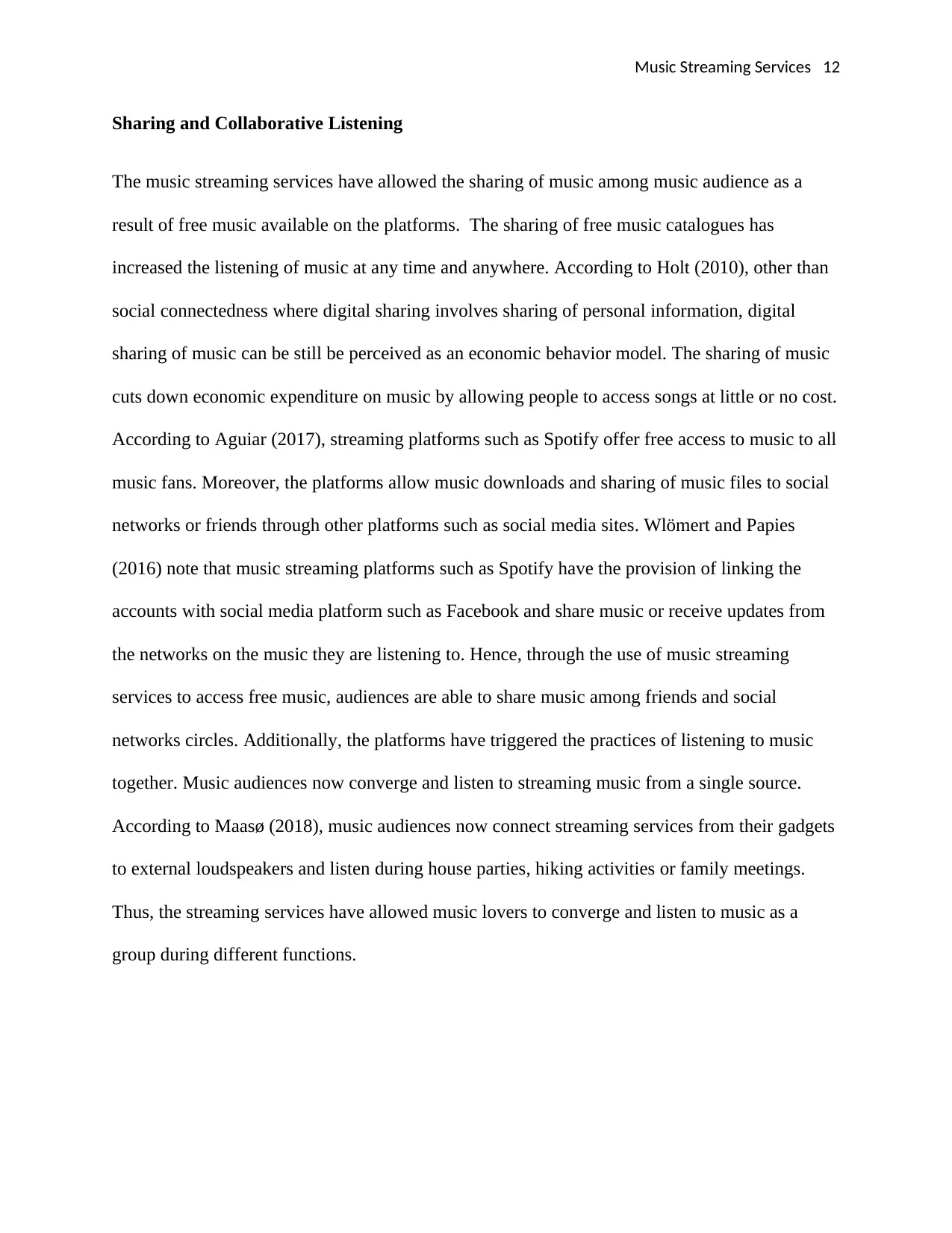
Music Streaming Services 12
Sharing and Collaborative Listening
The music streaming services have allowed the sharing of music among music audience as a
result of free music available on the platforms. The sharing of free music catalogues has
increased the listening of music at any time and anywhere. According to Holt (2010), other than
social connectedness where digital sharing involves sharing of personal information, digital
sharing of music can be still be perceived as an economic behavior model. The sharing of music
cuts down economic expenditure on music by allowing people to access songs at little or no cost.
According to Aguiar (2017), streaming platforms such as Spotify offer free access to music to all
music fans. Moreover, the platforms allow music downloads and sharing of music files to social
networks or friends through other platforms such as social media sites. Wlömert and Papies
(2016) note that music streaming platforms such as Spotify have the provision of linking the
accounts with social media platform such as Facebook and share music or receive updates from
the networks on the music they are listening to. Hence, through the use of music streaming
services to access free music, audiences are able to share music among friends and social
networks circles. Additionally, the platforms have triggered the practices of listening to music
together. Music audiences now converge and listen to streaming music from a single source.
According to Maasø (2018), music audiences now connect streaming services from their gadgets
to external loudspeakers and listen during house parties, hiking activities or family meetings.
Thus, the streaming services have allowed music lovers to converge and listen to music as a
group during different functions.
Sharing and Collaborative Listening
The music streaming services have allowed the sharing of music among music audience as a
result of free music available on the platforms. The sharing of free music catalogues has
increased the listening of music at any time and anywhere. According to Holt (2010), other than
social connectedness where digital sharing involves sharing of personal information, digital
sharing of music can be still be perceived as an economic behavior model. The sharing of music
cuts down economic expenditure on music by allowing people to access songs at little or no cost.
According to Aguiar (2017), streaming platforms such as Spotify offer free access to music to all
music fans. Moreover, the platforms allow music downloads and sharing of music files to social
networks or friends through other platforms such as social media sites. Wlömert and Papies
(2016) note that music streaming platforms such as Spotify have the provision of linking the
accounts with social media platform such as Facebook and share music or receive updates from
the networks on the music they are listening to. Hence, through the use of music streaming
services to access free music, audiences are able to share music among friends and social
networks circles. Additionally, the platforms have triggered the practices of listening to music
together. Music audiences now converge and listen to streaming music from a single source.
According to Maasø (2018), music audiences now connect streaming services from their gadgets
to external loudspeakers and listen during house parties, hiking activities or family meetings.
Thus, the streaming services have allowed music lovers to converge and listen to music as a
group during different functions.
⊘ This is a preview!⊘
Do you want full access?
Subscribe today to unlock all pages.

Trusted by 1+ million students worldwide
1 out of 19
Your All-in-One AI-Powered Toolkit for Academic Success.
+13062052269
info@desklib.com
Available 24*7 on WhatsApp / Email
![[object Object]](/_next/static/media/star-bottom.7253800d.svg)
Unlock your academic potential
Copyright © 2020–2025 A2Z Services. All Rights Reserved. Developed and managed by ZUCOL.


